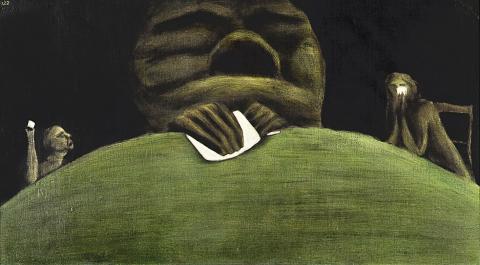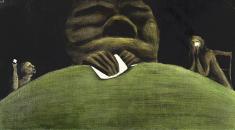Tony Fomison
Isn’t it my turn, 1976
Tony Fomison’s mysterious painting of a giant head looming over a green field, accompanied by two diminutive figures comes from one of the strongest and most distinctive periods of his career. It is a time when many of the European influences he absorbed a decade earlier had matured and melded with a very distinctive voice all of his own; and so it is that “Isn’t it my turn” marks Fomison as New Zealand’s Goya with its dramatic chiaroscuro and ominous but ambiguous mood.
Though primarily known for his painting, Tony Fomison (1939-1990) trained in Christchurch as a sculptor an after finishing art school travelled in Europe for three years, returning to Christchurch in 1967. He held his first exhibition at New Vision Gallery, Auckland, in 1972; and then moved to Auckland a year later. By 1976, he had amassed a large body of oil paintings, drawings and sculptures, which he exhibited mid-year at Barry Lett Galleries in a show that signalled a new and assured approach. The bi-cultural Fomison also emerged in these years, melding his Pakeha working-class Christchurch origins with a self-identification as Samoan marked in 1979 by his receiving the pe’a, the traditional Samoan legs and buttocks tattoo.
“Isn’t it my turn” demonstrates Fomison’s nuanced mastery of understated compositions and painterly surfaces. The three figures stand out from the simple black-brown and green planes through their strong chiaroscuro in ways that are reminiscent, but no longer derivative of Caravaggio, Fra Angelico and Goya. In addition, the treatment of the large central head shows how the artist’s earlier practice as a sculptor enabled him to render three-dimensional form with elegant deftness. The broad planes of green and dark paint also reveal his power as a painter: they are well-modulated and complex surfaces, avoiding the deadness that still inhabits broad expanses of single colours in the larger paintings.
The painting is a high point in Fomison’s oeuvre of romantic character paintings because of the figures’ brooding and ambiguous expression and relationship to each other. The central head conjures memories of carved Polynesian heads, which Fomison studied, and bears a similarity to other works of the period in which allegorical heads loom large over a landscape horizon in the manner of an anthropomorphised headland. As such, the figure may stand in for ancient wisdom; however here, its relationship to the seemingly furtive and supplicant figures on either side of what may be a hillside, or equally, a card table or boardroom table, also suggests the withholding of knowledge and by association, of power. These tones and ambiguities set Fomison apart as an inheritor of Goya’s ability to comment on the most malevolent human relations while investing an almost mystical or religious power in the aesthetic of the painting itself.
Tony Fomison, Isn’t it my turn 1976, oil on canvasboard, 455 x 810mm
Previously published in The David and Angela Wright Collection of Modern and Contemporary New Zealand Art, 30 June 2011, Art+Object the 21st Century Auction House, Auckland, pp22-23.

